This week, I had the opportunity to catch up with In Place artist, Sarah Marino. Sarah is an extremely talented illustrator, designer, and visual developer currently working at Reel FX Studio in the feature animation department. She graduated from Ringling College of Art and Design in 2009, and since, has been extremely busy creating works for companies such as Simon & Schuster, Blue Sky Studios, and CMYK Magazine, and has been exhibiting illustrations in galleries throughout the country.
It has been great getting to know Sarah through her participating in the exhibitions. It is clear in her personal practice as well as at work, she is collaboratively focused- a true team player! In this interview, Sarah shares her perspectives on feature animations, studio practice, keeping busy, and being passionate about your profession.
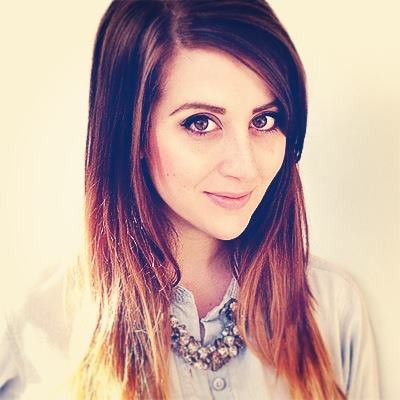
Can you tell us what you currently have in the works? What you are looking forward to?
Currently, I am on cast working on a film called the “Book of Life” with Guillermo Del Toro as creative producer and Jorge Gutierrez as director. It has been an amazing project to be involved with! I also recently wrapped on a project with Simon & Schuster.When I’m not at work, I like to make my own children’s book illustrations. All of these projects have been great because I like to keep busy! I feel guilty if I’m not working, so I’m glad I love making art so much!
You are a visual development artist for Reel FX. Could you talk a little about your role at the studio, your favorite parts of the process, and the community?
Working in animation doesn’t really feel like work – you’re making movies primarily for kids, so it’s great to use your imagination all day. As a vis dev artist, I work in the art department, which is the group of artists responsible for bringing each director’s vision to life. One thing that I really love about working on movies, is that even though you might be on a project for over a year, the range of assignments you undertake keeps it interesting and fun. Working at a younger studio like Reel FX also means the talent is fresh and passionate- it’s a really inspiring environment. Everyone I work with is amazingly talented and we’re all friends outside of work, which I don’t think is always the norm for most larger studios. I love the tight-knit community that’s developed even though our company has grown.
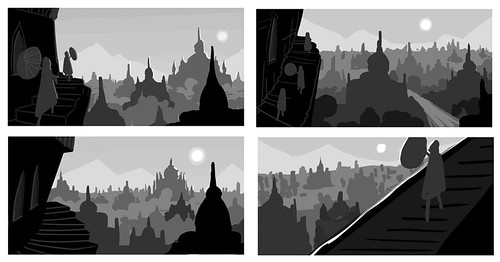
What do you think most people would find surprising about the type of work you do at work or the way an animation studio works?
Making movies is extremely collaborative. I would say a majority of the assignments I’m given have been worked on by someone else in some way, whether they already did sketches, designs, color keys, etc. I’m primarily a painter/surface artist, so a lot of the time I’ll be given a designer’s drawing, and flesh it out with color and form, explore what it’s made of (e.g. stone, wood, organic material, etc), and how it might be lit in a scene. A lot of the work you do in the beginning is exploratory, but once production deadlines hit, you just have to commit. Every assignment given to you is the art director trusting that you’ll make it happen in the allotted amount of time. Deadlines are so important in animation, especially when you’re at the beginning of the pipeline like those of us in the art department. Everything we do has to be passed on to the next department so they can begin bringing the movie to life.
What styles and work from your professional work carry into your personal work? Are the processes similar different?
I’ve learned just as much, if not more so, at my job than I did during school. The amount of talent that I’m surrounded by is really high, and I’ve taken a lot of inspiration from my peers. The biggest difference between what I do at work and what I do at home is the final product. When I do a book illustration or a personal piece, I’m putting a finished painting out there as a standalone image that I created from start to finish. Animation is a lot different – most of the work I do will never go public, and mostly everything I work on is only a concept of the final product, not actually the final.
For example, if I do a painting of what a certain prop might look like, I’ll paint it the way it should look in the movie, and then the CG artists will take my painting and sculpt, surface, animate, etc. the actual asset for the movie. It seems discouraging at first, but I actually find it really rewarding to see what the CG artists can do with the work I handoff to them. When I watch a movie I worked on, I can point at a certain prop or character and say ‘I created that. And my one friend modeled it, another textured it, another animated it.’ That collaborative part is something that I really love about animation.
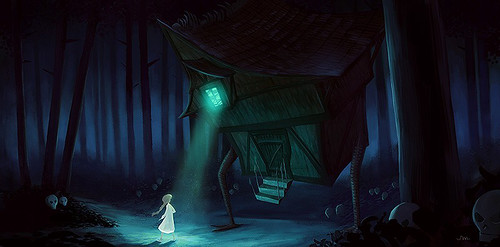
What personal projects do you have in the works? Is there anything you have been dying to create?
Storytelling is my passion, and even though I primarily tell stories with illustrations, I also love to write. One of my books in progress is an illustrated middle-grade fantasy novel. CTN Expo is coming up in a few months, so I’m going to try to see how many new pieces I can put together in time for that. There are a lot of old Russian and Eastern European fairy tales I’ve been researching in hopes to use as a jumping off point for a new body of vis dev work. The last thing I’ve been up to (this is the first time I’m saying so publicly, in fact), is that I’ve had the pleasure to do some voiceover work for FUNimation Studios, an anime distribution company here in the Dallas area. Being able to dub over for anime has been crazy fun, but also incredibly surreal! My first credit will be on the Fairy Tail movie coming out later this year.
You create beautiful landscapes and scenes everyday, and are well versed in fantastical imagery. How did you select your location for In Place? What were you drawn in by?
I'm really big on watching documentaries while I work, and luckily Netflix has a great selection of them. I had recently watched a documentary on Myanmar, and the Bagan Temples really stood out to me visually, despite the current disparity in the country. I instantly wanted to learn more about the history of the temples. I try to set goals for my work, and adding more larger scale landscapes to my portfolio was one of them. The In Place show was a great opportunity I had to jump on while the images of the temples still buzzed around in my head. With my work, I'm definitely attracted to subtleties and quieter moods, so learning about the history of the Bagan Temples and the monks who still inhabit them really resonated with my aesthetic and design philosophy.
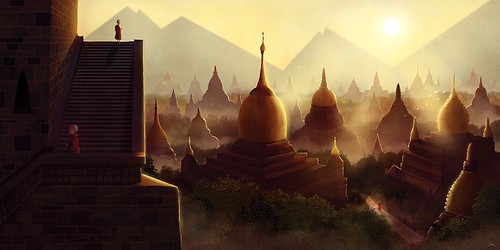
I spent some time searching for photography of the temples and referred to other documentaries. Especially with a piece like this that was so grounded in reality, I wanted to make sure I honored the history and architecture of the culture I would be illustrating. I think with the case of this piece, the reference images I found really inspired my thumbnails. I was drawn to the photographs that showed the temples in the early morning or late sunset and I knew I wanted to explore the foggy glow that bounces off the tops of the gold-gilded buildings. I was also really drawn to the monks and their day to day lives; how after all of these years, they still walk with purpose throughout such ancient and impressive structures.
What other topics inspire you when making? What are some of your favorite types of characters, scenes, stories?
I’m a sucker for anything whimsical, fantastical, or romantic, so if a story or character or place has anything to do with one or all of the above (huge bonus), then I’m immediately drawn to it. I actually made a list of a bunch of my favorite characters, and I found that my favorites tend to either be heroes (especially the reluctant kind, like Harry Potter or Sailor Moon) or dashing rogues with sensitive souls (e.g. Han Solo, Spike Spiegel). I’m a seriously hopeless romantic, and if two characters fall in love despite all the odds set against them, I’m completely invested emotionally. I’m sure this is probably why a lot of my work tends to feature heroines or couples. At least I’m consistent!
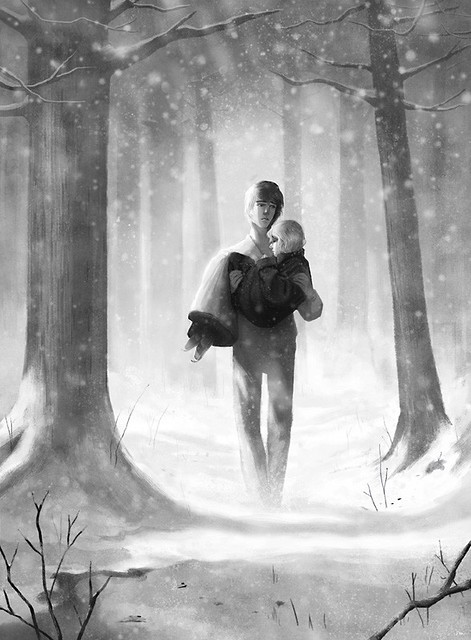
And lastly, do you have any advice for aspiring character developers?
Draw every single day. If you’re having a bad drawing day, seek out things that inspire you! Play guitar, go for a walk in the park, go to a bookstore or see a movie. There are so many resources out there today for people that want to work in animation–from workshops or online classes, to CTN Expo or SDCC. Networking will get you the job, so be friendly to everyone you meet in the industry–your work ethic and good attitude means more than your portfolio. Don’t be afraid to edit your portfolio. Submit your portfolio with work that applies to the job you want. It’s a competitive industry, but if you want it bad enough, and you work for it hard enough, you’ll get there. My path to being a vis dev artist wasn’t easy, but with a lot of hard work and dedication (and a little bit of luck), I made it. You can, too.
Thanks to Sarah for such a great and insightful interview! You can check out more of Sarah Marino's work on her website as well as check out her artwork for the In Place Exhibition and the In Place book on our Light Grey Shop.
It has been great getting to know Sarah through her participating in the exhibitions. It is clear in her personal practice as well as at work, she is collaboratively focused- a true team player! In this interview, Sarah shares her perspectives on feature animations, studio practice, keeping busy, and being passionate about your profession.

Can you tell us what you currently have in the works? What you are looking forward to?
Currently, I am on cast working on a film called the “Book of Life” with Guillermo Del Toro as creative producer and Jorge Gutierrez as director. It has been an amazing project to be involved with! I also recently wrapped on a project with Simon & Schuster.When I’m not at work, I like to make my own children’s book illustrations. All of these projects have been great because I like to keep busy! I feel guilty if I’m not working, so I’m glad I love making art so much!
You are a visual development artist for Reel FX. Could you talk a little about your role at the studio, your favorite parts of the process, and the community?
Working in animation doesn’t really feel like work – you’re making movies primarily for kids, so it’s great to use your imagination all day. As a vis dev artist, I work in the art department, which is the group of artists responsible for bringing each director’s vision to life. One thing that I really love about working on movies, is that even though you might be on a project for over a year, the range of assignments you undertake keeps it interesting and fun. Working at a younger studio like Reel FX also means the talent is fresh and passionate- it’s a really inspiring environment. Everyone I work with is amazingly talented and we’re all friends outside of work, which I don’t think is always the norm for most larger studios. I love the tight-knit community that’s developed even though our company has grown.

What do you think most people would find surprising about the type of work you do at work or the way an animation studio works?
Making movies is extremely collaborative. I would say a majority of the assignments I’m given have been worked on by someone else in some way, whether they already did sketches, designs, color keys, etc. I’m primarily a painter/surface artist, so a lot of the time I’ll be given a designer’s drawing, and flesh it out with color and form, explore what it’s made of (e.g. stone, wood, organic material, etc), and how it might be lit in a scene. A lot of the work you do in the beginning is exploratory, but once production deadlines hit, you just have to commit. Every assignment given to you is the art director trusting that you’ll make it happen in the allotted amount of time. Deadlines are so important in animation, especially when you’re at the beginning of the pipeline like those of us in the art department. Everything we do has to be passed on to the next department so they can begin bringing the movie to life.
What styles and work from your professional work carry into your personal work? Are the processes similar different?
I’ve learned just as much, if not more so, at my job than I did during school. The amount of talent that I’m surrounded by is really high, and I’ve taken a lot of inspiration from my peers. The biggest difference between what I do at work and what I do at home is the final product. When I do a book illustration or a personal piece, I’m putting a finished painting out there as a standalone image that I created from start to finish. Animation is a lot different – most of the work I do will never go public, and mostly everything I work on is only a concept of the final product, not actually the final.
For example, if I do a painting of what a certain prop might look like, I’ll paint it the way it should look in the movie, and then the CG artists will take my painting and sculpt, surface, animate, etc. the actual asset for the movie. It seems discouraging at first, but I actually find it really rewarding to see what the CG artists can do with the work I handoff to them. When I watch a movie I worked on, I can point at a certain prop or character and say ‘I created that. And my one friend modeled it, another textured it, another animated it.’ That collaborative part is something that I really love about animation.

What personal projects do you have in the works? Is there anything you have been dying to create?
Storytelling is my passion, and even though I primarily tell stories with illustrations, I also love to write. One of my books in progress is an illustrated middle-grade fantasy novel. CTN Expo is coming up in a few months, so I’m going to try to see how many new pieces I can put together in time for that. There are a lot of old Russian and Eastern European fairy tales I’ve been researching in hopes to use as a jumping off point for a new body of vis dev work. The last thing I’ve been up to (this is the first time I’m saying so publicly, in fact), is that I’ve had the pleasure to do some voiceover work for FUNimation Studios, an anime distribution company here in the Dallas area. Being able to dub over for anime has been crazy fun, but also incredibly surreal! My first credit will be on the Fairy Tail movie coming out later this year.
You create beautiful landscapes and scenes everyday, and are well versed in fantastical imagery. How did you select your location for In Place? What were you drawn in by?
I'm really big on watching documentaries while I work, and luckily Netflix has a great selection of them. I had recently watched a documentary on Myanmar, and the Bagan Temples really stood out to me visually, despite the current disparity in the country. I instantly wanted to learn more about the history of the temples. I try to set goals for my work, and adding more larger scale landscapes to my portfolio was one of them. The In Place show was a great opportunity I had to jump on while the images of the temples still buzzed around in my head. With my work, I'm definitely attracted to subtleties and quieter moods, so learning about the history of the Bagan Temples and the monks who still inhabit them really resonated with my aesthetic and design philosophy.

I spent some time searching for photography of the temples and referred to other documentaries. Especially with a piece like this that was so grounded in reality, I wanted to make sure I honored the history and architecture of the culture I would be illustrating. I think with the case of this piece, the reference images I found really inspired my thumbnails. I was drawn to the photographs that showed the temples in the early morning or late sunset and I knew I wanted to explore the foggy glow that bounces off the tops of the gold-gilded buildings. I was also really drawn to the monks and their day to day lives; how after all of these years, they still walk with purpose throughout such ancient and impressive structures.
What other topics inspire you when making? What are some of your favorite types of characters, scenes, stories?
I’m a sucker for anything whimsical, fantastical, or romantic, so if a story or character or place has anything to do with one or all of the above (huge bonus), then I’m immediately drawn to it. I actually made a list of a bunch of my favorite characters, and I found that my favorites tend to either be heroes (especially the reluctant kind, like Harry Potter or Sailor Moon) or dashing rogues with sensitive souls (e.g. Han Solo, Spike Spiegel). I’m a seriously hopeless romantic, and if two characters fall in love despite all the odds set against them, I’m completely invested emotionally. I’m sure this is probably why a lot of my work tends to feature heroines or couples. At least I’m consistent!

And lastly, do you have any advice for aspiring character developers?
Draw every single day. If you’re having a bad drawing day, seek out things that inspire you! Play guitar, go for a walk in the park, go to a bookstore or see a movie. There are so many resources out there today for people that want to work in animation–from workshops or online classes, to CTN Expo or SDCC. Networking will get you the job, so be friendly to everyone you meet in the industry–your work ethic and good attitude means more than your portfolio. Don’t be afraid to edit your portfolio. Submit your portfolio with work that applies to the job you want. It’s a competitive industry, but if you want it bad enough, and you work for it hard enough, you’ll get there. My path to being a vis dev artist wasn’t easy, but with a lot of hard work and dedication (and a little bit of luck), I made it. You can, too.
Thanks to Sarah for such a great and insightful interview! You can check out more of Sarah Marino's work on her website as well as check out her artwork for the In Place Exhibition and the In Place book on our Light Grey Shop.
